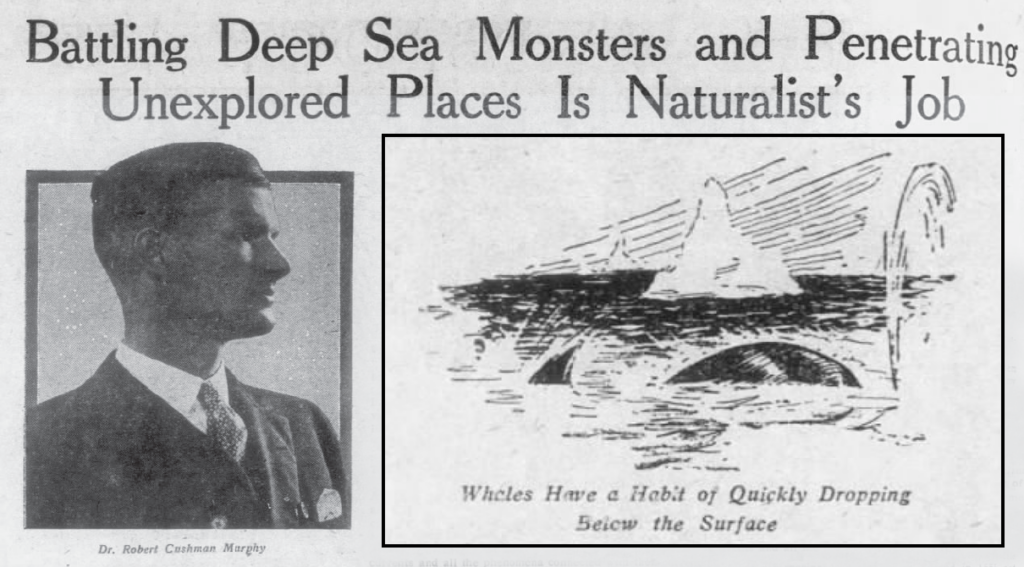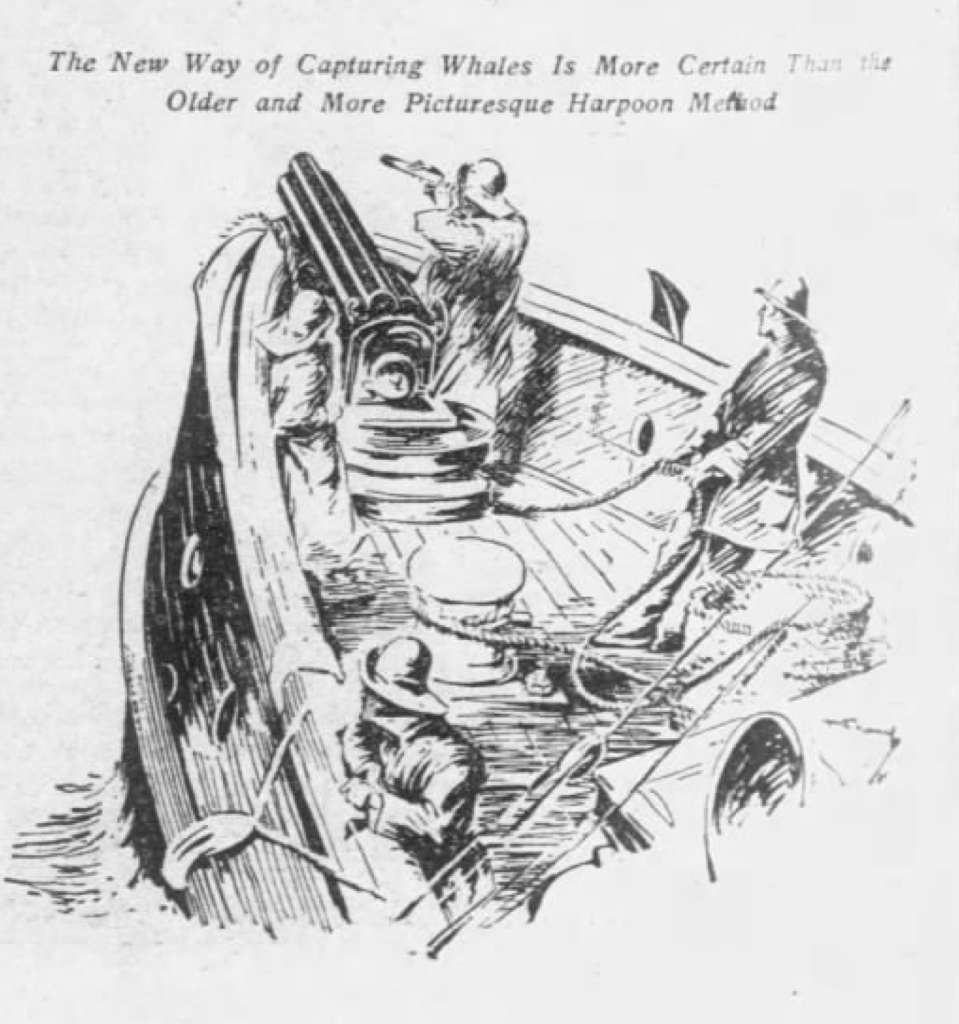From Battling “Deep Sea Monsters” to Conserving Them
“Battling Deep Sea Monsters” sounds like a synopsis of the classic novel by French writer Jules Verne, Twenty Thousand Leagues Under the Seas. Instead, it’s something that could have been listed on the resume of Robert Cushman Murphy, a fellow of The New York Academy of Sciences (the Academy) more than a century ago.
Published May 6, 2025
By Nick Fetty

Robert Cushman Murphy was born in Brooklyn, New York, in 1887 to a family that had lived in the city for four generations. His father was a school principal, likely influencing his passion of learning. He frequented the Brooklyn Museum and got involved in his first bird study at the age of seven, when he studied a nest of chickadees. He eventually befriended the naturalist and explorer George K. Cherrie. An Iowa-born mechanical engineer by training, Cherrie later became a museum curator and was part of Theodore Roosevelt’s South American expedition in 1913-14.
“I have always been interested in natural science,” Murphy said in a 1925 article in the Brooklyn Eagle newspaper. “The first naturalist I ever knew well was George K. Cherrie. That was when I was only nine or ten years old and he will always remain a very great hero to me. I used to spend all my spare time at the Brooklyn Museum, and Mr. Cherrie’s friendship did much to stimulate me.”
An Expedition to the Subantarctic
Murphy went on to earn an undergraduate degree from Brown University. Upon graduating in 1911, he was appointed curator of birds and mammals at the Brooklyn Institute of Arts and Sciences. The following year he worked as a naturalist on a whaling ship for an expedition to the subantarctic.
“During its stop of almost four months for elephant seals on South Georgia Island, he obtained specimens of penguins, other birds, marine mammals, and plants, which were all to be deposited in the American Museum of Natural History,” according to Stony Brook University’s Special Collections and University Archives.

While certain practices around whaling are considered unsustainable to today’s standards, Murphy detailed the thrill of doing battle with “sea beasts”. In particular, he found the methods on the “old-fashioned” clipper ships to be the most exciting.
“A harpoon was planted in the whale and a small boat tied to it. In spite of the fact that you have three hundred fathoms of line ready to let out, if the whale dives, which it almost invariably does, it gives you none too comfortable a feeling to find the nose of the small boat suddenly awash,” Murphy recounted in that 1925 Brooklyn Eagle article.
His reputation was, in part, based on his physique, described as “a good deal over six foot” and “with dark hair and expressive, deep-set eyes.”
“He was dressed in tweed knickerbockers and looked much more like a college athlete than a scientist with an impressive list of degrees after his name,” the 1925 Brooklyn Eagle article reported. “Athletic qualification might be found quite as useful as scientific background in a profession which requires an ability to wrestle with recalcitrant whales and other deep-sea monsters.”
From the Caribbean to the Mediterranean
Many of Murphy’s scientific contributions are not well known, but nonetheless impactful. Upon returning from his whaling adventures, he went on to earn an advanced degree in zoology from Columbia University. He then became a curator for the American Museum of Natural History (AMNH). (The Academy and its affiliates at the time played a role in establishing the AMNH, which opened its doors in 1869.)
Murphy continued his globetrotting. In the coming years, he would take excursions to Mexico, Peru, Ecuador, Panama, and other parts of the Caribbean, as well as the western Mediterranean and New Zealand. He published his first book Bird Islands of Peru in 1925 and his second book The Oceanic Birds of South America in 1936. The latter would win the John Burroughs Medal for excellence in natural history writing as well as the Brewster Medal from the American Ornithologists Union.
Murphy’s wife, Grace Emeline (Barstow) Murphy, was his partner in both his personal life and his professional pursuits. The duo worked together in the 1930s to catalog a collection of more than a quarter million bird specimens that had been accumulated by British zoologist Lionel Walter Rothschild. The collection was displayed at the AMNH.
During the 1912 whaling voyage, Robert sent frequent letters to his wife, which along with entries from his diary, served as the basis for his Logbook for Grace, published in 1947. Throughout his career, Robert Murphy published nearly 600 articles in both scientific journals and popular magazine press, including National Geographic and Scientific Monthly.
A Productive Retirement
Murphy formally retired from the AMNH in 1955 and remained active in an emeritus capacity. In 1960, he was part of a National Science Foundation-funded expedition through the Antarctic on “Glacier”, an icebreaker ship. In 1970, he returned to South Georgia Island, the place that jumpstarted his scientific career nearly 60 years prior.
Murphy published Fish-Shape Paumanok: Nature and Man on Long Island in 1962, “a charming little volume on the Long Island he knew so intimately, having walked the length and breadth of it from his early years,” according to American ornithologist and AMNH curator Dean Amadon. The book borrowed its name from “Strating from Paumanok,” a poem by fellow Long Islander, Walt Whitman. In 1967, he published A Dead Whale or a Stove Boat, which included a series of whaling photos from his 1912 voyage.
Later in his life, Murphy understood the detrimental environmental impact of whaling, and alongside Grace became involved with various conservation and preservation efforts. Robert became the first president of the Long Island chapter of the Nature Conservancy, while Grace founded Conservationists United for Long Island. Though his lawsuit against the government to stop spraying the chemical pesticide dichlorodiphenyltrichloroethanes (DDT) did not gain adequate traction, it did help to set the stage for later successful efforts, such as those led by Silent Spring author Rachel Carson.
Despite holding degrees from two Ivy League universities, Murphy was perhaps most proud of his honorary doctorate from the University of San Marcos. The Lima, Peru-based university is the oldest in the western hemisphere.
A Lasting Legacy
Robert Cushman Murphy died in 1973, at the age of 85. With a strong work ethic until the day he died, he was known for “still driving sixty miles into New York City and back, over that terrifying Long Island Expressway,” wrote Dean Amadon, the American ornithologist and AMNH curator, in an in memoriam following Murphy’s death.
During his life, Murphy was a member of the American Association for the Advancement of Science, the American Geographical Society, the American Philosophical Society, the Explorers’ Club, and the Long Island Biological Association. He was elected a fellow of The New York Academy of Sciences, meaning that he was selected by active members for his scientific achievement.
Murphy’s legacy has been memorialized in various ways. He lived to see Trachurus murphyi, a fish species also known as the Chilean jack mackerel, named in his honor. Furthermore, Robert Cushman Murphy Junior High School in Stony Brook was named after him in 1969. Posthumously, Robert Cushman Murphy Peconic River County Park was named in his honor in 1987. At the time, it was the largest park in Suffolk County. The Murphys were both also elected to the Long Island Hall of Fame.
Both Robert and Grace Murphy made crucial contributions in the realm of conservation specifically and biological science more broadly. Nearly two and a half decades after Robert’s passing, Steve Englebright, a former New York State Assembly member representing Long Island, reflected on the lasting impact of the explorer once known for “battling deep sea monsters.”
“Robert Cushman Murphy was the greatest scientist and naturalist Long Island ever produced,” Englebright told The New York Times in 1998. “We have our first national parks directly because of Robert Cushman Murphy’s leadership.”
Also read: One of Early America’s Engineering Marvels
